2023 Annual Report for: Elachistidae / Elachistinae
For species seen in 2023 that had less than or equal to 100 records, full details are included; for more common species, the earliest, latest and highest count by vice-county are shown. The narrative for each species is taken from the main Hantsmoths website, and it is possible that some information on abundance and occurrence can get out of date, as it is impossible to keep up with all changes; however it should give a good introduction to each species. The tables in each species account summarise the previous status, and that for the current year.
For the maps, all records prior to 2023 are shown by a blue dot (the larger the dot, the more recent), with the current year's records shown in red. As previous records are superimposed on any report for 2023, new sites have greater emphasis (i.e. will show as 'more red').
In the species accounts, an asterisk next to a location indicates a new 10km square record; earliest ever dates are highlighted in orange, and latest ever in red. Initials in the species accounts refer to the recorders listed here. Please get in touch if you identify any omissions or errors, in particular if you have records that have yet to be submitted. Details of how to submit records can be found here.
38.001 [B&F: 0590] Perittia obscurepunctella (Stainton, 1848) - Nationally Scarce B
Nationally scarce (Nb) in open woodland throughout much of England, more numerous in the south. Probably under-recorded in Hampshire and on the Isle of Wight, where the extent of known records correlate with those areas in which the recording effort is concentrated, but probably rather uncommon in the north of the county. Wingspan 8-10 mm. An obscurely marked species best confirmed by examination of the genitalia which are distinctive in both sexes (MBGBI Vol 3). Larva mines leaves of Honeysuckle, over-wintering as a pupa.
Records prior to 2023
| Vice County | #Records | #Individuals | First Record | Last Record |
|---|---|---|---|---|
| 10 | 7 | 3 | 1900 | 2007 |
| 11 | 23 | 20 | 1974 | 2011 |
| 12 | 5 | 6 | 1997 | 2014 |
2023 records
| Vice County | #Records | #Individuals | Max Quantity |
|---|---|---|---|
| 11 | 4 | 2 | 1 |
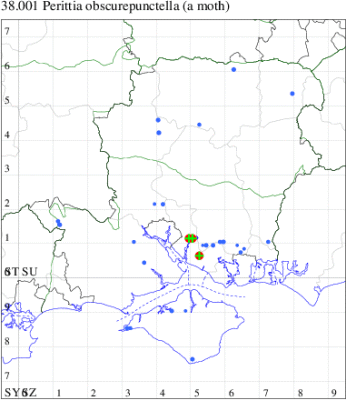
Records by year
Records by week (adult)
Records by week (larval)
Record Details
VC11: Manor Farm Country Park*, mine, present, 11 Jun; Kites Croft LNR, Fareham, mine, present, on Honeysuckle. , 13 Jun; Manor Farm Country Park, mine, one, 11 Jun (DPH)
38.003 [B&F: 0592] Stephensia brunnichella (Linnaeus, 1767) - Nationally Scarce B
Nationally scarce (Nb) in deciduous woodland and woodland margins, on chalky soils, in England from the Wash-Mersey line southwards and also in the north; in Wales from Glamorgan (MBGBI Vol 3). In Hampshire and on the Isle of Wight this species occurs along the borders of woods on calcareous downland, and has been found in several localities in the county, notably at Leckford and Stockbridge Down in the north, and Portsdown NR and Oxenbourne in the south. Not recorded from the Isle of Wight since 1938. Wingspan 8-9 mm. Imago similar to many of the Elachista species, although the white band on the antenna at three-quarters is distinctive. Larva mines leaves of Wild Basil.
Records prior to 2023
| Vice County | #Records | #Individuals | First Record | Last Record |
|---|---|---|---|---|
| 10 | 1 | 0 | 1938 | 1938 |
| 11 | 33 | 67 | 1937 | 2019 |
| 12 | 13 | 11 | 1982 | 2012 |
2023 records
| Vice County | #Records | #Individuals | Max Quantity |
|---|---|---|---|
| 11 | 1 | 2 | 2 |
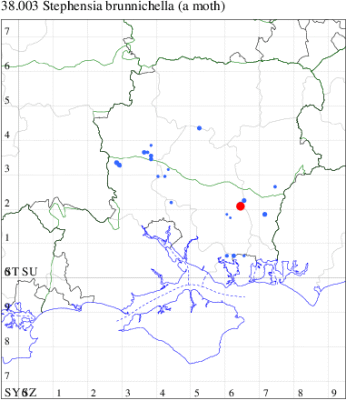
Records by year
Records by week (adult)
Records by week (larval)
Record Details
VC11: Old Winchester Hill NNR, two, field observation, adults swept around wild basil. , 29 Jul (WLan)
38.004 [B&F: 0610] Elachista argentella (Clerck, 1759) - Common
Common in grassland and saltmarshes throughout much of the British Isles. In Hampshire and on the Isle of Wight widespread and common, particularly near the coast. Wingspan 11-12 mm. The only plain white species other than Mendesia farinella, from which it can be separated by its smaller size, non-ciliate antenna and reduced venation (MBGBI Vol 3). Larva mines leaves of various grasses.
Records prior to 2023
| Vice County | #Records | #Individuals | First Record | Last Record |
|---|---|---|---|---|
| 10 | 99 | 131 | 1856 | 2021 |
| 11 | 321 | 408 | 1972 | 2022 |
| 12 | 98 | 134 | 1976 | 2021 |
2023 records
| Vice County | #Records | #Individuals | Max Quantity |
|---|---|---|---|
| 11 | 7 | 8 | 2 |
| 12 | 6 | 9 | 5 |
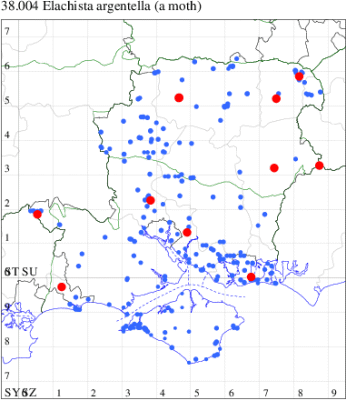
Records by year
Records by week (adult)
Records by week (larval)
Record Details
VC11: Romsey, one, 26 Jun (NRJ); Wildern LNR, Hedge End, one, field observation, 02 May (TCrw det. JOug); Portsmouth, two, 12 Jun (IRT); Hurn, one, field observation, by day sitting on fescue grass in garden. , 17 May; one, 17 May; one, 10 Jun; one, 17 Jun (MJef);
VC12: Cole Henley, one, 24 May; one, 17 Jun (GCE); Noar Hill HIWWT NR, Selborne, one, 09 Jun (AMD, FHay det. AMD); Odiham Common, present, field observation, 28 May (AMit); Hammer Bridge, Woolmer, one, field observation, 25 May (ASwa); Minley Wood, five, field observation, 30 May (BGD)
38.012 [B&F: 0617] Elachista obliquella Stainton, 1854 - Nationally Scarce B
Nationally scarce (Nb) in woodland rides and edges throughout much of England. In Hampshire and on the Isle of Wight thinly distributed, except for the usual concentration of records in the south-east of the county and from Botley Wood in particular. Wingspan 8-10 mm. Very similar to E. cingillella, but margins of the transverse white fascia rather ill-defined in E. obliquella, fascia bounded on both sides by blackish suffusion in E. cingillella. Larva mines leaves of False-brome, Upright Brome and various grasses.
Records prior to 2023
| Vice County | #Records | #Individuals | First Record | Last Record |
|---|---|---|---|---|
| 10 | 6 | 2 | 1900 | 2014 |
| 11 | 51 | 50 | 1974 | 2022 |
| 12 | 7 | 3 | 1975 | 2010 |
2023 records
| Vice County | #Records | #Individuals | Max Quantity |
|---|---|---|---|
| 11 | 2 | 2 | 1 |

Records by year
Records by week (adult)
Records by week (larval)
Record Details
VC11: Botley Wood, mine, one, 31 Dec; mine, one, on False-brome. , 31 Dec (DPH)
38.015 [B&F: 0620] Elachista gangabella Zeller, 1850 - Local
Local in woodland in southern England and Wales, rare elsewhere. Very sparsely, but widely, distributed across Hampshire and the Isle of Wight. Wingspan 9-10 mm. Distinguished from all other unifasciate Elachista species by the dark apical cilia on the forewing (MBGBI Vol 3). Larva mines leaves of Cock's-foot and False-brome.
Records prior to 2023
| Vice County | #Records | #Individuals | First Record | Last Record |
|---|---|---|---|---|
| 10 | 8 | 12 | 1977 | 2010 |
| 11 | 52 | 33 | 1982 | 2019 |
| 12 | 27 | 6 | 1975 | 2020 |
2023 records
| Vice County | #Records | #Individuals | Max Quantity |
|---|---|---|---|
| 11 | 3 | 2 | 1 |
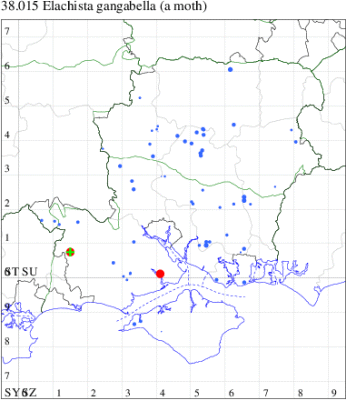
Records by year
Records by week (adult)
Records by week (larval)
Record Details
VC11: Blashford Lakes HIWWT NR*, mine, present, brachypodium sylvaticum, 14 Oct (JOug); Needs Ore NNR, one, 02 Jul (CNB); one, 02 Jul (PCra)
38.017 [B&F: 0622] Elachista adscitella Stainton, 1851 - Nationally Scarce B
Nationally scarce (Nb) in woodland clearings in parts of England, Wales and southern Ireland. In Hampshire there have been a handful of records but not recorded from the Isle of Wight to date. Wingspan 9-11 mm. One of several, similar Elachista species, which are reliably separated only by dissection of the genitalia. Larva mines leaves of Tufted Hair-grass and Blue Moor-grass.
Records prior to 2023
| Vice County | #Records | #Individuals | First Record | Last Record |
|---|---|---|---|---|
| 11 | 5 | 4 | 1976 | 2017 |
| 12 | 1 | 1 | 2015 | 2015 |
2023 records
| Vice County | #Records | #Individuals | Max Quantity |
|---|---|---|---|
| 11 | 2 | 2 | 1 |

Records by year
Records by week (adult)
Records by week (larval)
Record Details
VC11: Crab Wood, Winchester, mine, one, deschampsia cespitosa, 21 Mar; Shedden Oak Copse, West Wood*, mine, one, deschampsia cespitosa, 21 Mar (JOug)
38.018 [B&F: 0623] Elachista bisulcella (Duponchel, [1843]) - Local
Local in deciduous woodland and woodland edges throughout much of Britain and scattered localities in the southern half of Ireland. In Hampshire and on the Isle of Wight present in all three vice-counties, but found only commonly in Botley Wood, south Hampshire, and only scattered records across all three vice-counties elsewise. Wingspan 8-10 mm. The yellow outer edge of the fascia usually distinguishes this species. Larva mines leaves of Tufted Hair-grass and Tall Fescue.
Records prior to 2023
| Vice County | #Records | #Individuals | First Record | Last Record |
|---|---|---|---|---|
| 10 | 3 | 3 | 1926 | 2022 |
| 11 | 38 | 28 | 1978 | 2022 |
| 12 | 3 | 2 | 1986 | 2017 |
2023 records
| Vice County | #Records | #Individuals | Max Quantity |
|---|---|---|---|
| 11 | 2 | 2 | 1 |
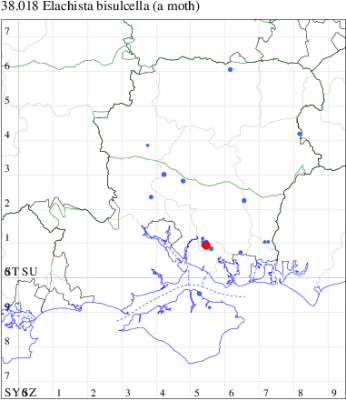
Records by year
Records by week (adult)
Records by week (larval)
Record Details
VC11: Botley Wood, one, det gen m., 08 Sep; one, male gen det. , 08 Sep (F.M.G.)
38.019 [B&F: 0593] Elachista regificella Sircom, 1849 - Nationally Scarce B
Nationally scarce (Nb) in open woodland in parts of the British Isles, mostly in the south (MBGBI Vol 3). First recorded in our area in 2023, when two mines were found on Luzula sylvatica at Sandy Balls, New Forest (Jack Oughton). Wingspan 8-9 mm. A fairly distinctive, well-marked, black and white elachistid. Larva mines leaves of Great Wood-rush.
Records prior to 2023
| Vice County | #Records | #Individuals | First Record | Last Record |
|---|
2023 records
| Vice County | #Records | #Individuals | Max Quantity |
|---|---|---|---|
| 11 | 1 | 2 | 2 |
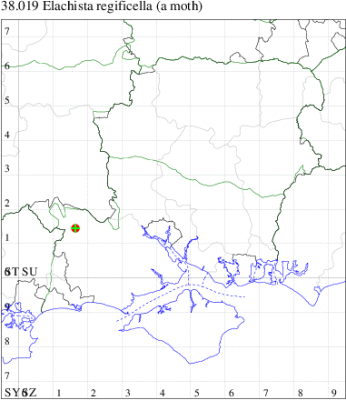
Records by year
Records by week (adult)
Records by week (larval)
Record Details
VC11: New Vice-county Record: Sandy Balls, NF*, mine, two, luzula sylvatica, 26 Mar (JOug)
38.022 [B&F: 0594] Elachista gleichenella (Fabricius, 1781) - Local
Local in woodland throughout much of the British Isles. In Hampshire there are old records from Leckford and Chilbolton, and from Havenstreet Wood on the Isle of Wight, but the only recent records are from Botley Wood and Magdalen Hill. Wingspan 8-9 mm. A fairly distinctive, well-marked, black and white elachistid. Larva mines leaves of Wood-rush and Sedge.
Records prior to 2023
| Vice County | #Records | #Individuals | First Record | Last Record |
|---|---|---|---|---|
| 10 | 1 | 1 | 1978 | 1978 |
| 11 | 12 | 13 | 2004 | 2014 |
| 12 | 4 | 2 | 1985 | 1999 |
2023 records
| Vice County | #Records | #Individuals | Max Quantity |
|---|---|---|---|
| 11 | 2 | 4 | 3 |
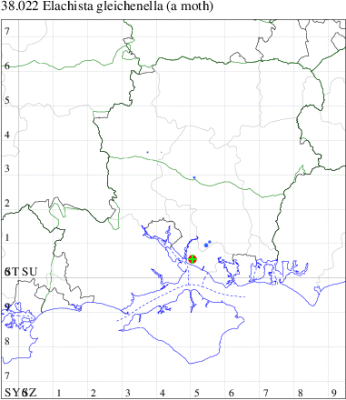
Records by year
Records by week (adult)
Records by week (larval)
Record Details
VC11: Warsash Common, mine, three, 3 mines, 2 tenanted, on Pendulous Sedge. , 12 Mar (DPH)
38.023 [B&F: 0595] Elachista biatomella (Stainton, 1848) - Nationally Scarce B
Nationally scarce (Nb) on open grassland and heathland throughout England and Wales. In Hampshire restricted to sites such as Portsdown Hill, Martin Down and Oxenbourne Down, with occasional records elsewhere, including one on the Isle of Wight on Culver Down, Bembridge. Wingspan 7-9 mm. Larva mines leaves of Glaucous Sedge.
Records prior to 2023
| Vice County | #Records | #Individuals | First Record | Last Record |
|---|---|---|---|---|
| 10 | 7 | 1 | 1900 | 2018 |
| 11 | 25 | 35 | 1971 | 2020 |
| 12 | 3 | 2 | 1976 | 2013 |
2023 records
| Vice County | #Records | #Individuals | Max Quantity |
|---|---|---|---|
| 11 | 1 | 0 | 0 |
| 12 | 1 | 1 | 1 |
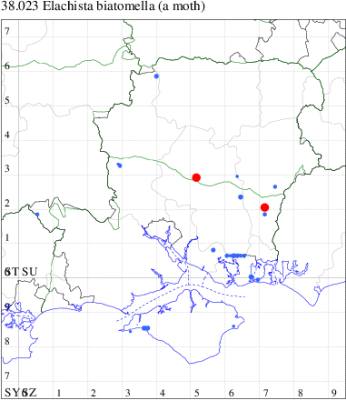
Records by year
Records by week (adult)
Records by week (larval)
Record Details
VC11: Butser Hill*, present, netted, frequent, 29 Jul (AMD);
VC12: Morn Hill, Winchester*, one, 08 Jul (CRB, PDF, DAS, LHur)
38.025 [B&F: 0597] Elachista atricomella Stainton, 1849 - Common
Common on roadside verges, woodland edges and waste ground throughout the British Isles. Probably under-recorded in Hampshire and on the Isle of Wight, where the extent of known records correlate with those areas in which the recording effort is concentrated. Wingspan 11-13 mm. Well-marked males, with dark head and centrally weak fascia are distinctive, but poorly marked specimens can only be identified by dissection of the genitalia. Larva mines leaves of Cock's-foot.
Records prior to 2023
| Vice County | #Records | #Individuals | First Record | Last Record |
|---|---|---|---|---|
| 10 | 18 | 19 | 1967 | 2022 |
| 11 | 78 | 99 | 1972 | 2022 |
| 12 | 103 | 148 | 1976 | 2022 |
2023 records
| Vice County | #Records | #Individuals | Max Quantity |
|---|---|---|---|
| 11 | 2 | 2 | 1 |
| 12 | 2 | 24 | 23 |
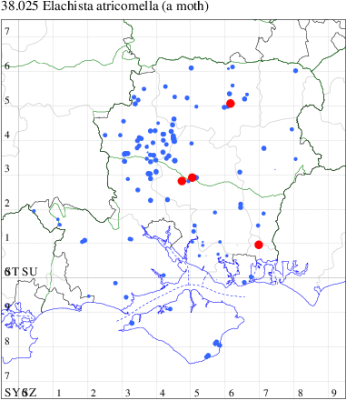
Records by year
Records by week (adult)
Records by week (larval)
Record Details
VC11: Winchester, one, 30 Jun (THW); Waterlooville, one, 11 Sep (DWhe);
VC12: Magdalen Hill Down NNR, 23, 10 Jun (KArb, SIng, PPea); Basingstoke, one, 20 Jul (RHil)
38.028 [B&F: 0599] Elachista alpinella Stainton, 1854 - Nationally Scarce B
Nationally scarce (Nb) in marshes, water-meadows and other damp areas throughout most of the British Isles. In Hampshire known in the past from Titchfield Haven and Leckford. Not recorded from the Isle of Wight to date. Wingspan 9-13 mm. A rather variable species, however, the dark head and incomplete fascia separate it from E. atricomella and E. kilmunella, but the small obscure upland form can easily be passed over as E. humilis (MBGBI Vol 3). Larva mines leaves of various sedges.
Records prior to 2023
| Vice County | #Records | #Individuals | First Record | Last Record |
|---|---|---|---|---|
| 11 | 9 | 10 | 2004 | 2021 |
| 12 | 5 | 4 | 1987 | 2007 |
2023 records
| Vice County | #Records | #Individuals | Max Quantity |
|---|---|---|---|
| 12 | 2 | 2 | 1 |

Records by year
Records by week (adult)
Records by week (larval)
Record Details
VC12: Fleet Pond*, one, field observation, 02 Sep; one, 06 Sep (MHals)
38.029 [B&F: 0600] Elachista luticomella Zeller, 1839 - Local
Local on woodland edges and rides, roadside verges and waste ground throughout much of the British Isles, except for the Outer Hebrides, Orkney and Shetland. In Hampshire there are widespread, scattered records and rare in recent years; however 2023 saw a welcome report from Noar Hill. On the Isle of Wight, recorded only once, at Luccombe Farm in July 1999. Wingspan 10-11 mm. The yellowish head-colour is usually diagnostic but in faded specimens the ochreous tinge to the white wing markings will help (MBGBI Vol 3). Larva mines leaves of Cock's-foot and False-brome.
Records prior to 2023
| Vice County | #Records | #Individuals | First Record | Last Record |
|---|---|---|---|---|
| 10 | 3 | 3 | 1999 | 1999 |
| 11 | 9 | 1 | 1986 | 2010 |
| 12 | 1 | 0 | 1999 | 1999 |
2023 records
| Vice County | #Records | #Individuals | Max Quantity |
|---|---|---|---|
| 12 | 1 | 1 | 1 |
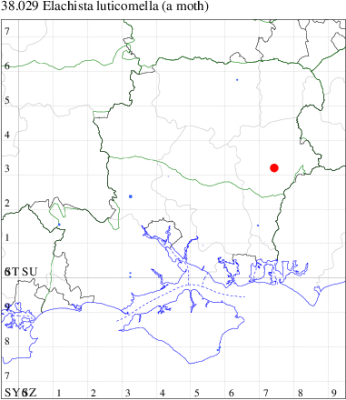
Records by year
Records by week (adult)
Records by week (larval)
Record Details
VC12: Noar Hill HIWWT NR, Selborne*, one, gen. det., 09 Jun (AMD, FHay det. AMD)
38.030 [B&F: 0601] Elachista albifrontella (Hübner, [1817]) - Common
Common in grassland, woodland and gardens throughout much of the British Isles, but apparently absent from the extreme north of Scotland, the Orkney and Shetland Isles (MBGBI Vol 3). In Hampshire widespread and fairly common; on the Isle of Wight, recorded only one, at Bembridge in June 1969. Wingspan 8-9 mm. Similar to E. apicipunctella, which see for differences. Larva mines leaves of various grasses.
Records prior to 2023
| Vice County | #Records | #Individuals | First Record | Last Record |
|---|---|---|---|---|
| 10 | 4 | 1 | 1850 | 1969 |
| 11 | 124 | 471 | 1968 | 2022 |
| 12 | 31 | 22 | 1940 | 2022 |
2023 records
| Vice County | #Records | #Individuals | Max Quantity |
|---|---|---|---|
| 11 | 1 | 1 | 1 |
| 12 | 2 | 2 | 1 |
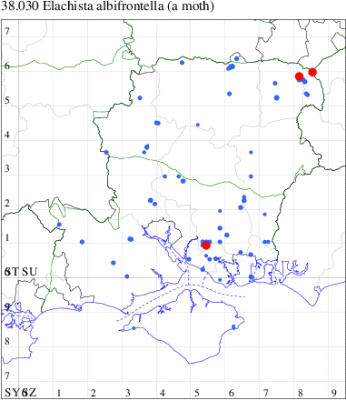
Records by year
Records by week (adult)
Records by week (larval)
Record Details
VC11: Botley Wood, one, male. , 09 Jun (F.M.G.);
VC12: Minley Wood, one, field observation, 30 May; Blackwater, one, 17 Jun (BGD)
38.032 [B&F: 0602] Elachista apicipunctella Stainton, 1849 - Local
Local along woodland edges and in woodland clearings throughout much of the British Isles, except for the extreme south-west of England. In Hampshire there is a single old record from "Southampton" in 1937, but the precise place where the specimen was taken is uncertain (MBGBI Vol 3). No more was heard of the species in the county until May 2002, when one was found in a Rothamsted trap at West Park. There have been further scattered records from 2020 onwards. Not recorded from the Isle of Wight to date. Wingspan 10-11 mm. Similar to E. albifrontella, but the extra subapical spot beyond the costal and tornal spots of the forewing on E. apicipunctella is diagnostic. Larva mines leaves of various grasses.
Records prior to 2023
| Vice County | #Records | #Individuals | First Record | Last Record |
|---|---|---|---|---|
| 11 | 1 | 1 | 1937 | 1937 |
| 12 | 3 | 6 | 2018 | 2022 |
2023 records
| Vice County | #Records | #Individuals | Max Quantity |
|---|---|---|---|
| 11 | 1 | 1 | 1 |
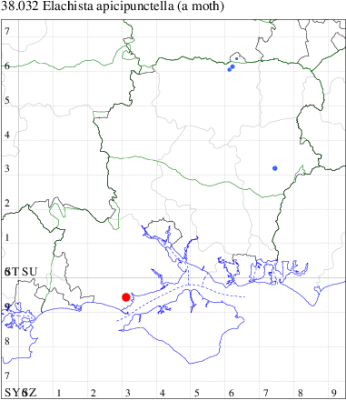
Records by year
Records by week (adult)
Records by week (larval)
Record Details
VC11: Pennington*, one, 09 Jun (RFC)
38.036 [B&F: 0606] Elachista humilis Zeller, 1850 - Common
Common in a wide range of habitats throughout much of Britain, but not in the Highlands or Islands of Scotland; rare in Ireland. In Hampshire reasonably well-distributed in the south of the county, but very infrequent in the north and on the Isle of Wight; probably under-recorded. Wingspan 9-10 mm. The male is extremely similar to the small, poorly-marked upland form of E. alpinella from which it can often reliably be separated only by dissection of the genitalia (MBGBI Vol 3). Larva mines leaves of various grasses.
Records prior to 2023
| Vice County | #Records | #Individuals | First Record | Last Record |
|---|---|---|---|---|
| 10 | 4 | 4 | 1986 | 2015 |
| 11 | 129 | 149 | 1983 | 2022 |
| 12 | 14 | 18 | 1992 | 2022 |
2023 records
| Vice County | #Records | #Individuals | Max Quantity |
|---|---|---|---|
| 11 | 1 | 2 | 2 |
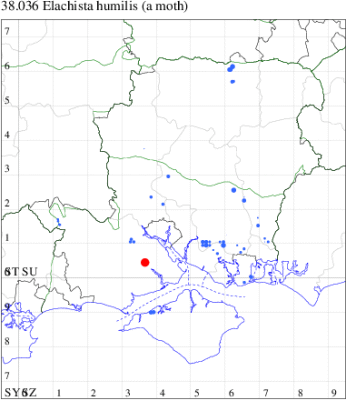
Records by year
Records by week (adult)
Records by week (larval)
Record Details
VC11: Culverley, NF*, two, gen det, 30 May (CLew)
38.037 [B&F: 0607] Elachista canapennella (Hübner, [1813]) - Common
Common in grassland throughout much of the British Isles. In Hampshire widespread and reasonably common, but perhaps under-recorded; there have been no recent records from the Isle of Wight. Wingspan 8-10 mm. The male is usually recognisable by its pale grey-brown forewings that are almost devoid of markings (MBGBI Vol 3). Larva mines leaves of various grasses.
Records prior to 2023
| Vice County | #Records | #Individuals | First Record | Last Record |
|---|---|---|---|---|
| 10 | 142 | 197 | 1900 | 2022 |
| 11 | 852 | 1197 | 1968 | 2022 |
| 12 | 94 | 144 | 1994 | 2022 |
2023 records
| Vice County | #Records | #Individuals | Max Quantity |
|---|---|---|---|
| 11 | 31 | 66 | 9 |
| 12 | 3 | 3 | 1 |
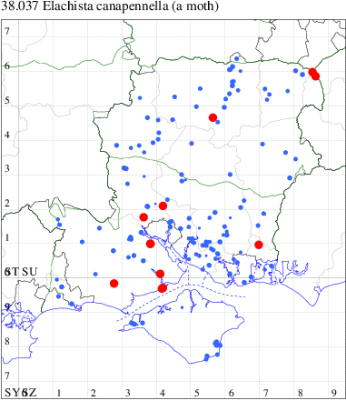
Records by year
Records by week (adult)
Records by week (larval)
Record Details
VC11: Marchwood, two, 26 May; nine, 28 May; one, 31 May; seven, 03 Jun; one, 09 Jun; one, 03 Sep; one, 19 May; one, 21 May; one, 24 May; four, 28 May; one, 31 May; one, 01 Jun; eight, 03 Jun; one, 07 Jun; two, 09 Jun; Lee, one, 13 May; one, 27 May; two, 28 May; two, 03 Jun; three, 09 Jun; one, 17 Jun (CTha); Needs Ore NNR, one, 02 Jul; one, 24 Jul (PCra); Chandler's Ford, one, 27 Aug (KArb); Waterlooville, one, 08 Sep (DWhe); Sway, one, 19 Aug; one, 05 Sep; two, 07 Sep (SKee); Needs Ore NNR, one, 01 Jul (CNB); one, 23 Jul (PCra);
VC12: North Waltham, one, 01 Jul (AJon); Blackwater, one, 27 Jun; Hawley Meadows, one, field observation, 11 Jun (BGD)
38.038 [B&F: 0608] Elachista rufocinerea (Haworth, 1828) - Common
Common in grassland, bogs and heaths throughout the British Isles, but not in northern Scotland. The distribution in Hampshire mirrors those areas in which trapping effort is concentrated, and the moth is probably more widely distributed than the records suggest, but very infrequently recorded on the Isle of Wight. Wingspan 10-11 mm. The reddish ochreous suffusion on a plain ochreous-white ground is diagnostic (MBGBI Vol 3). Larva mines leaves of various grasses.
Records prior to 2023
| Vice County | #Records | #Individuals | First Record | Last Record |
|---|---|---|---|---|
| 10 | 15 | 9 | 1850 | 2021 |
| 11 | 166 | 354 | 1968 | 2022 |
| 12 | 51 | 86 | 1971 | 2022 |
2023 records
| Vice County | #Records | #Individuals | Max Quantity |
|---|---|---|---|
| 11 | 1 | 1 | 1 |
| 12 | 5 | 20 | 12 |
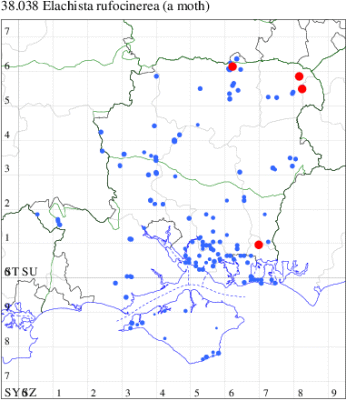
Records by year
Records by week (adult)
Records by week (larval)
Record Details
VC11: Waterlooville, one, 04 May (DWhe);
VC12: Pamber Forest, three, 04 May (GJD); Minley Wood, two, field observation, 03 May; two, field observation, 04 May (BGD); Fleet Pond, one, field observation, 26 Apr; 12, netted, 04 May (MHals)
38.039 [B&F: 0609] Elachista maculicerusella (Bruand, 1859) - Common
Common in fens and marshes and by rivers and canals throughout much of the British Isles, extending into Scotland as far north as the southern Highlands (MBGBI Vol 3). In Hampshire, widespread and common, but not recorded from the Isle of Wight until one in 2021. Wingspan 10mm. Fairly distinctive, although frequently quite variable. Larva mines leaves of Reed Canary-grass and Common Reed.
Records prior to 2023
| Vice County | #Records | #Individuals | First Record | Last Record |
|---|---|---|---|---|
| 10 | 1 | 1 | 2021 | 2021 |
| 11 | 50 | 59 | 1900 | 2021 |
| 12 | 54 | 71 | 1980 | 2021 |
2023 records
| Vice County | #Records | #Individuals | Max Quantity |
|---|---|---|---|
| 11 | 4 | 4 | 1 |
| 12 | 1 | 1 | 1 |
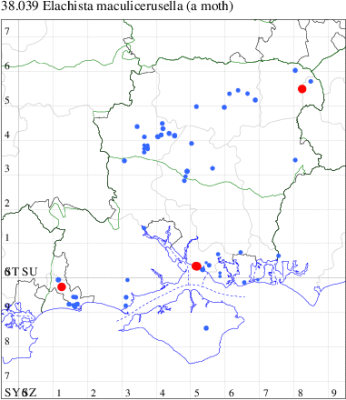
Records by year
Records by week (adult)
Records by week (larval)
Record Details
VC11: Brownwich cliffs, one, 07 Jul; Brownwich Cliffs, Titchfield, one, 07 Jul (F.M.G.); Hurn, one, 09 Jun; one, 14 Jul (MJef);
VC12: Fleet Pond, one, 17 Aug (MHals)
38.041 [B&F: 0625] Elachista cinereopunctella (Haworth, 1828) - Nationally Scarce B
Nationally scarce (Nb) on limestone grassland, fens and dune slacks throughout much of the British Isles, except for the Outer Hebrides, Orkney and Shetland. In Hampshire recorded in the past from Leckford, Chilbolton, Portsdown, Sparsholt and Chappet's Copse, West Meon. Not recorded from the Isle of Wight to date. Wingspan 7-9 mm. A reasonably distinctive, well-marked, black and white, elastichid. Larva mines leaves of Glaucous Sedge.
Records prior to 2023
| Vice County | #Records | #Individuals | First Record | Last Record |
|---|---|---|---|---|
| 11 | 7 | 2 | 1983 | 2014 |
| 12 | 3 | 2 | 1985 | 1986 |
2023 records
| Vice County | #Records | #Individuals | Max Quantity |
|---|---|---|---|
| 11 | 2 | 4 | 2 |
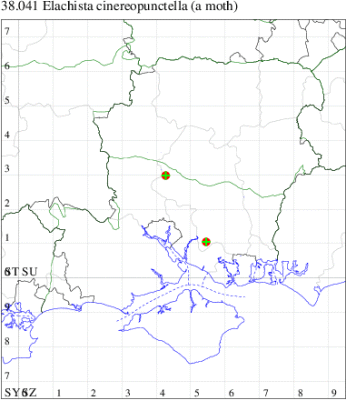
Records by year
Records by week (adult)
Records by week (larval)
Record Details
VC11: Crab Wood, Winchester, mine, two, carex flacca, 21 Mar (JOug); Botley Wood*, mine, two, on Carex sp. , 31 Dec (DPH)
38.045 [B&F: 0629] Elachista utonella Frey, 1856 - Nationally Scarce B
Nationally scarce (Nb) in bogs and on acid heaths throughout much of England and Ireland. In Hampshire apparently restricted to Leckford, Emer Bog, Titchfield Haven, Winnall Moors and the Moors NR, Bishop's Waltham, and strangely absent from the New Forest; there have been no recent records from the Isle of Wight. Wingspan 8-9 mm. Can be reliably separated from other similar Elachista species only by dissection of the genitalia. Larva mines leaves of various sedges.
Records prior to 2023
| Vice County | #Records | #Individuals | First Record | Last Record |
|---|---|---|---|---|
| 10 | 2 | 1 | 1900 | 1969 |
| 11 | 44 | 74 | 1987 | 2011 |
| 12 | 11 | 8 | 1984 | 2010 |
2023 records
| Vice County | #Records | #Individuals | Max Quantity |
|---|---|---|---|
| 11 | 1 | 1 | 1 |
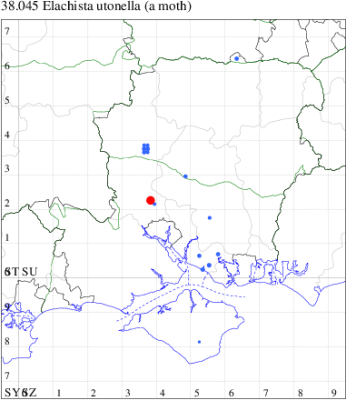
Records by year
Records by week (adult)
Records by week (larval)
Record Details
VC11: Romsey, one, gen det. , 22 Aug (NRJ det. DJG)
38.046 [B&F: 0630] Elachista albidella Nylander, [1848] - Local
Local on bogs and acid heaths throughout the British Isles. In Hampshire found mainly in boggy areas of the New Forest, where occasionally abundant and probably under-recorded, and on the heaths of north-east Hampshire; Not recorded from the Isle of Wight to date. Wingspan 9-10 mm. A small, nondescript moth, the main feature is an elongate dark brown spot on fold just before one-half, often entirely on a white ground colour (MBGBI Vol 3). Larva mines leaves of Deergrass, Slender Tufted-sedge, Greater Pond-sedge and Common Spike-rush.
Records prior to 2023
| Vice County | #Records | #Individuals | First Record | Last Record |
|---|---|---|---|---|
| 11 | 16 | 106 | 1981 | 2013 |
| 12 | 3 | 1 | 1998 | 1999 |
2023 records
| Vice County | #Records | #Individuals | Max Quantity |
|---|---|---|---|
| 11 | 1 | 3 | 3 |

Records by year
Records by week (adult)
Records by week (larval)
Record Details
VC11: Needs Ore NNR*, three, 24 Jul (PCra)
38.047 [B&F: 0631] Elachista freyerella (Hübner, [1825]) - Local
Local in damp meadows and woodland rides throughout the British Isles. In Hampshire recorded regularly only at Botley Wood, elsewhere in the county, and on the Isle of Wight, recorded very occasionally, and absent from many ten-kilometre squares. Wingspan 7-8 mm. Usually impossible to separate from C. consortella and C. stabilella without dissection of the genitalia, but C. freyerella tends to be darker with more obvious fasciae. Larva mines leaves of various grasses.
Records prior to 2023
| Vice County | #Records | #Individuals | First Record | Last Record |
|---|---|---|---|---|
| 10 | 4 | 3 | 1928 | 1984 |
| 11 | 96 | 125 | 1972 | 2022 |
| 12 | 16 | 13 | 1971 | 2011 |
2023 records
| Vice County | #Records | #Individuals | Max Quantity |
|---|---|---|---|
| 11 | 1 | 1 | 1 |
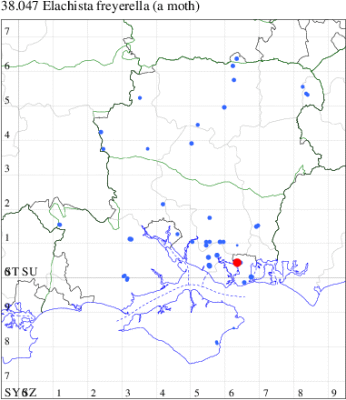
Records by year
Records by week (adult)
Records by week (larval)
Record Details
VC11: Horsea Island, one, male gen det. , 16 Jun (F.M.G. det. RJD)
38.049 [B&F: 0633] Elachista stabilella Stainton, 1858 - Nationally Scarce B
Nationally scarce (Nb) on grassland in parts of south-eastern England, with records north to Yorkshire. In Hampshire known only from the Portsmouth area, where first recorded in 2000, and where it is frequently taken at light; recorded in the past from Freshwater and Ventnor, Isle of Wight, but not on the Island since 1928. Recorded from Blackwater, VC12 in June 2023. Wingspan 7-8 mm. Larva mines leaves of various grasses.
Records prior to 2023
| Vice County | #Records | #Individuals | First Record | Last Record |
|---|---|---|---|---|
| 10 | 2 | 0 | 1850 | 1928 |
| 11 | 31 | 32 | 1999 | 2018 |
| 12 | 1 | 1 | 2008 | 2008 |
2023 records
| Vice County | #Records | #Individuals | Max Quantity |
|---|---|---|---|
| 11 | 3 | 3 | 1 |
| 12 | 1 | 1 | 1 |
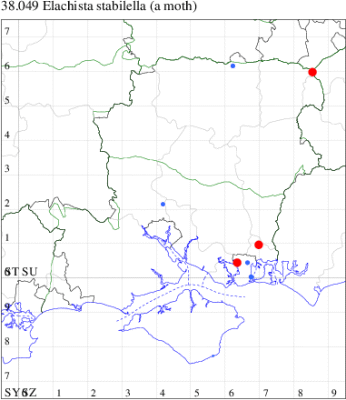
Records by year
Records by week (adult)
Records by week (larval)
Record Details
VC11: Horsea Island, one, male gen det. , 29 Sep; one, 29 Sep (F.M.G.); Waterlooville, one, 17 Jun (DWhe);
VC12: Blackwater*, one, gen det. , 17 Jun (BGD)
 on False-brome.jpg)
 on False-brome.jpg)





